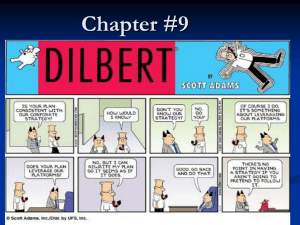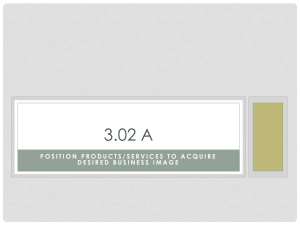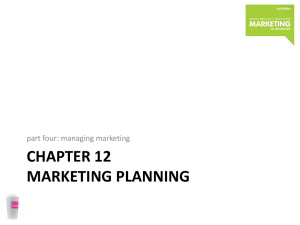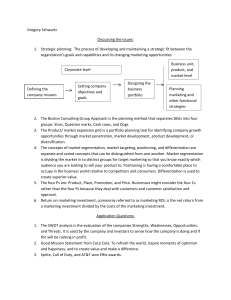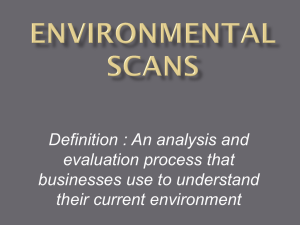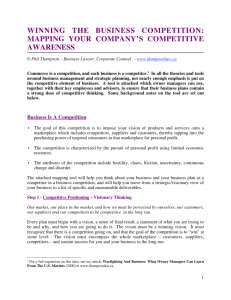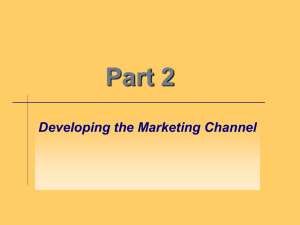A Framework for Operations Strategy today’s world
advertisement
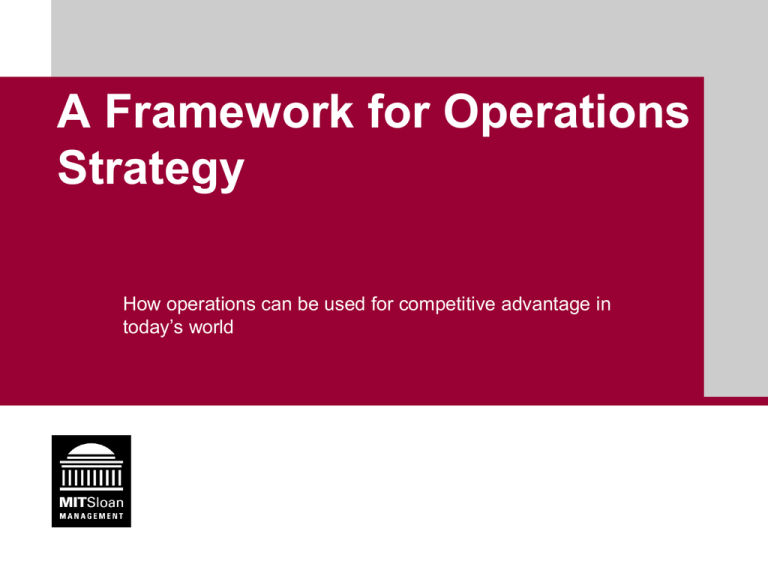
A Framework for Operations Strategy How operations can be used for competitive advantage in today’s world Problem One: Conflicts • • • • 2 More capacity Variety Cost Meeting targets • • • • Better forecasts Economical operations Other strategic criteria Maintaining quality Problem Two: Role in Strategy Marketing Finance Sales Strategic Planning R&D Corporate Plans Manufacturing 3 We first address some business strategy issues • Which businesses should we be in? • How do we compete and compare with our competitors in each one? • What dimensions of customer performance do we focus on • To answer these questions, we first look at alternative views of how individual businesses compete 4 Competitive Strategy: The Positioning View Sources of Barriers to Entry • Economies of scale • Product differentiation and brand loyalty • Capital requirements • Switching costs • Access to distribution channels • Cost disadvantages independent of scale • Proprietary product technology • Favorable access to raw materials • Favorable locations • Government subsidies • Learning or experience curve • Government policy New Entrants threat Buyers Have Power When: bargaining power Sources of Intense Rivalry 5 • Numerous or equally balanced competitors • Slow industry growth • High fixed or storage costs • Capacity augmented in large increments • Diverse competitors • High strategic stakes • High exit barriers Industry Competitors threat Suppliers • Fewer suppliers than those supplied • No substitute products • Industry is not an important customer • Suppliers’ input is important to industry • Supplier products are differentiated or switching costs are high • Suppliers may forward integrate bargaining power Buyers Suppliers Have Power When: • Buyers are concentrated or purchase large volumes relative to industry sales • Purchases represent a significant fraction of their costs • Products purchased are standard or undifferentiated • Buyers face few switching costs • Buyers earn low profits • Buyers can backward integrate • Products purchased are unimportant to quality of buyers’ products • Buyer has full information Substitutes May Become a Threat When: • Good price performance • Low switching costs • Industry is willing to substitute Substitutes Source: Adapted from Porter Competitive Strategy: The Positioning View • Positioning is based on the external market, industry dynamics, and the structure of the value chain volume growth Time 6 Competitive Strategy: The Positioning View • Options for firm positioning: – Cost leadership – Differentiation • And, by focusing on segments – Distinct customer groups – Groups with similar needs • BUT, assumes operations excellence is not a source of competitive advantage 7 Competitive Strategy: The Resource-Based View • Competitive advantage is derived from the firm’s development of unique bundles of resources and capabilities that are: – Inimitable: are difficult or costly to imitate or replicate – Valuable: allow the firm to improve its market position relative to competitors – Rare: in relatively short supply 8 Competitive Strategy: The Resource-Based View • Resource: an observable, but not necessarily tangible, asset that can be valued and traded – e.g., brand, patent, parcel of land, license – Asset or input to production than an organization owns, controls or has access to on a semi-permanent basis • Capability: not observable, and hence necessarily intangible, cannot be valued and changes hands only as part of an entire unit – Processes, activities or functions performed within a system – Utilize the organization's resources – Example: How a company innovates 9 Competitive Strategy: The Resource-Based View • Types of capabilities – Process-based • e.g., McDonald’s – Systems- or coordination-based • e.g., Ritz-Carlton • e.g., Southwest Airlines – Organization-based • e.g., Toyota – Network-based • e.g., Dell and the fulfillment supply chain • e.g., Cisco and the technology suppliers 10 Competitive Strategy: Integrating the Positioning and Resource-Based Views Capabilities Process Coordination Organization Network 11 Positioning Cost Leadership Differentiation Focus The process must then involve three levels: • Corporate • Business Unit • Function 12 …as well as customer goals • • • • • 13 Cost Quality Availability Features/Innovativeness Environmental Performance …yielding an integrated framework Complementors Capabilities Business Strategy Competitors Positioning Cross-Functional Integration (Fit) Suppliers Finance and Accounting Operations Time Delay Human Resources Marketing Research and Development Functional Strategies 14 Customers • Cost • Quality • Availability • Features/ Innovativeness • Environmental Performance The essence is internal/external and functional fit External Influences Internal Influences Industry Forces - Industry attractiveness - Competitive structure: opportunities and threats Strategic Plan: Gaining and Maintaining Competitive Advantage Goals Objectives Organization’s “Culture” - Competitive priorities - Capabilities: Sources of strengths/weaknesses Functional Strategies 15 Mktg. Ops. Finance R&D But there is a fourth level! Fourth level: Decision Category Approach • The decision category approach examines manufacturing decision categories for consistency with strategic vision – Structural decisions • Bricks and mortar • Machinery – Infrastructure • People • Systems • Procedures – Fit with business, corporation, and other functions 16 Companies vary considerably on this ideal approach • • • • • 17 Use of both capabilities and positioning Formality of process Type of formal method Input of operations Focus on all decision categories Major Manufacturing Decision Categories 1. FACILITIES • size • location • focus 2. CAPACITY • amount • timing • type 3. VERTICAL INTEGRATION AND SUPPLIER MANAGEMENT (The technology supply chain) • direction • extent • interfaces • collaboration 4. PRODUCTION TECHNOLOGIES AND PROCESSES • equipment • automation • interconnectedness • scale • flexibility 5. WORK FORCE AND MANAGEMENT • RFI? • Policies (wages, security, etc.) • skill levels 18 6. INFORMATION TECHNOLOGIES • use and level of investment • parity or differentiation 7. SUPPLY CHAIN AND MATERIALS (The fulfillment supply chain) • logistics facilities and methods • inventory policies • vendor relations • production planning 8. ORGANIZATION AND INCENTIVES • structure • reporting levels • degree of centralization • role of staff • control/reward systems • costing systems 9. BUSINESS PROCESSES • product generation • interfaces • responsibilities • vendor development • order fulfillment • service and support • quality and CI, flexibility, and other cross-cutting capabilities IT decisions • • • • How much to invest Where to focus investment Standardized or customized applications Should IT be standardized within the company – Standardization allows common learning and implementation advantages – But there is less flexibility for local needs • Organization, implementation and measurement • Parity or competitive advantage 19 Measures of Performance The strategic mission matches the organization’s strengths to a limited set of external measures of performance • • 20 Operations Costs – Unit costs – Total (volume) costs – Lifetime costs Availability – Percentage of on-time shipments – Response to results for info or changes – Product and volume flexibility – Delivery time • • • Quality – Return rate – Product reliability and durability – Cost and rate of field repairs Innovativeness and Features – Product innovativeness – Time to market and development cycle Environmental Performance – Ease of disassembly and recycling – Use of resources Decision Categories map to 3D concurrent engineering Product Process Process technology Capacity Facilities IT Business Processes- PG Supply Chain Fulfillment SC Materials mgmt Supplier mgmt Vertical integration Infrastructure – HR, organization, IT infrastructure, other business processes 21 Identify the right measures! 22 The Classic Strategies Strategy Technology Infrastructure Marketing & Sales • Low unit cost • Specialized equipment • Materials planning and control • Narrow line • Price • High service level • Reserve capacity • Inventory • Dependability • Wide line custom products • Flexible machines • Reserve capacity • Worker skills • Customer needs and scheduling • Product innovation • General purpose • Development • Team skills • Market leadership • New segments 23 Present Operations Policies Operations Unit Decision Category Production technologies & processes Capacity Workforce & management 24 Description of Past Policy Strengths Weaknesses Summary of decision category framework • Understanding of external (value chain, dynamics, competitors, etc.) and internal (capabilities) • Consistency at four levels (corporation, business, function, and decision category) • Strategy is pattern of decisions within the nine categories • Strategy is the identification of the competitive priorities from the five means of competition 25 MIT OpenCourseWare http://ocw.mit.edu 15.769 Operations Strategy Fall 2010 For information about citing these materials or our Terms of Use, visit: http://ocw.mit.edu/terms.
